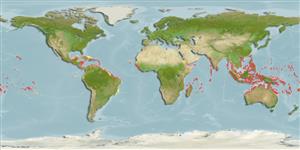Common names from other countries
Environment: milieu / climate zone / depth range / distribution range
Ecología
Pelágico; rango de profundidad 0 - 10 m (Ref. 59262). Subtropical; 22°C - ? (Ref. 84934); 23°N - 24°S, 39°E - 6°W
Indo-Pacific, Atlantic Ocean and the Arctic: from Mozambique east to northern Australia and Colombia and Brazil, north to Hawaii and south to Pitcairn Islands.
Length at first maturity / Tamaño / Peso / Age
Maturity: Lm ? range ? - ? cm Max length : 77.0 cm TL macho / no sexado; (Ref. 8812); peso máximo publicado: 1.5 kg (Ref. 356)
Culmen: 8.47 cm; tarsus: 3.5 cm; wing: 40.7 cm.
Total Length: 66 to 77 cm; Wingspan: 91 to 101 cm (Ref. 8812). Wingspan: 152 cm. The smallest booby (Ref. 91362). Causes of decrease in population is human exploitation, habitat destruction especially in the Western Indian Ocean, predation by rats, and tourism disturbance (84934). Found <200 m offshore, over deep waters (Ref. 356). Colonial breeder in trees on marine islands. Gregarious; freely approaches ships, undertaking long foraging trips (Ref. 91362). Exhibits plunge diving (Ref. 356). Maturity at past 2 to 3 years (Ref. 91362).
Li, X. 1990. (Ref. 78638)
IUCN Red List Status (Ref. 130435)
CITES status (Ref. 108899)
Not Evaluated
Not Evaluated
Human uses
| FishSource |
Herramientas
Fuentes de Internet
Estimates based on models
Resiliencia
Alto, población duplicada en un tiempo mínimo inferior a 15 meses (K=8.78-18.23).
Vulnerability
Moderate to high vulnerability (51 of 100).
Price category
Unknown.
